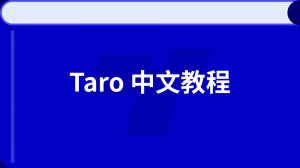阅读(3153)
赞(0)
Render Props
2020-05-12 15:05:14 更新
自 1.3.5 起支持
render props 是指一种在 Taro 组件之间使用一个值为函数的 prop 共享代码的简单技术。
具有 render prop 的组件接受一个函数,该函数返回一个 Taro 元素并调用它而不是实现自己的渲染逻辑。
举个例子,假设我们有一个组件,它可以呈现一张在屏幕上追逐鼠标的猫的图片。我们或许会使用 <Cat mouse={{ x, y }} prop 来告诉组件鼠标的坐标以让它知道图片应该在屏幕哪个位置。
我们可以提供一个带有函数 prop 的 <Mouse> 组件,它能够动态决定什么需要渲染的,而不是将 <Cat> 硬编码到 <Mouse> 组件里,并有效地改变它的渲染结果。
// cat.js
import catImage from './cat.jpg'
class Cat extends Taro.Component {
static defaultProps = {
mouse: {
x: 0,
y: 0
}
}
render() {
const { mouse } = this.props;
return (
<Image src={catImage} style={{ position: 'absolute', left: mouse.x, top: mouse.y }} />
);
}
}
// mouse.js
class Mouse extends Taro.Component {
constructor(props) {
super(props);
this.handleMouseMove = this.handleClick.bind(this);
this.state = { x: 0, y: 0 };
}
handleClick(event) {
const { x, y } = event.detail
this.setState({
x,
y
});
}
render() {
return (
<View style={{ height: '100%' }} onClick={this.handleClick}>
{/*
我们可以把 prop 当成一个函数,动态地调整渲染内容。
*/}
{this.props.renderCat(this.state)}
</View>
);
}
}
// MouseTracker.js
class MouseTracker extends Taro.Component {
render() {
return (
<View>
<View>点击鼠标!</View>
{/*
Mouse 如何渲染由 MouseTracker 的状态控制
*/}
<Mouse renderCat={mouse => (
<Cat mouse={mouse} />
)}/>
</View>
);
}
}
现在,我们提供了一个 render 方法 让 <Mouse> 能够动态决定什么需要渲染,而不是克隆 <Mouse> 组件然后硬编码来解决特定的用例。
更具体地说,render prop 是一个用于告知组件需要渲染什么内容的函数 prop。
这项技术使我们共享行为非常容易。要获得这个行为,只要渲染一个带有 render prop 的 <Mouse> 组件就能够告诉它当前鼠标坐标 (x, y) 要渲染什么。
注意事项
render props 是基于小程序 slot 机制实现的。 因此它受到的限制和 children 与组合的限制一样多

